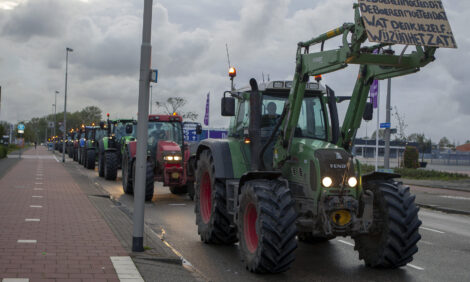



LMC: Strong Prices Paid for Heifers in Recent Weeks
NORTHERN IRELAND, UK - Producers will be pleased to see a rising trade at the moment but in recent weeks, it has become clear that there is quite a difference between base quotes from the factories and reported prices, particularly in the case of heifers.These reported prices show that more money is being paid for prime cattle than quotes would suggest. Last week factories paid an average of 339p/kg for U-3= grade heifers. The top quote was 326p/kg in one plant. Most factories were quoting 324p/kg for U-3 heifers.
Differences between prices and quotes
There are various reasons for differences between
quotes and reported prices. One obvious reason,
commonly cited, is that average prices reported
by the plants include Angus and Hereford stock
which drives up these reported prices and can
cause a difference between those and base
quotes which are exclusive of such bonuses.
The quotes provided to LMC by factories also
exclude the bonuses paid by factories for in-spec
cattle. For example, most factories were quoting
324p/kg last week for U-3 grade heifers; one plant
reported quotes up to 326p/kg. With many of
those cattle attracting the 8p/kg in-spec bonus,
the actual price is obviously going to be higher
than quotes and reported prices of around 330-
332p/kg will be more likely depending on how
many cattle are in-spec. However, the reported U-
3= price was much higher again at 339p/kg.
The drawback of looking at sub-grades (+/-/=) is
that a couple of outliers can have a significant
impact on the average price because there may
only be a small number of cattle in a particular
sub-grade. There were just 26 U-3= heifers last
week for example. Base grades (for example, U3)
which include all combinations of +/=/- ought to
provide a better indication of prices for
comparison with quotes.
The overall U3 grade heifer price last week was
337p/kg (excl. Angus and Hereford). Based on
last week’s base U-3 heifer quote of 324-326p/kg,
this would require that almost all U3 heifers were
U+ grade (+4p/kg on the grid) and in-spec, an
unlikely scenario. An average price of 337p/kg for
U3 heifers also begs the question; if this is the
average, what is the range? Some prices clearly
must be higher again.
The curse of the average
Average prices for cattle are very useful in that
they give a general idea about how the trade
performed in any given week and these figures are
comparable from one week to the next. However,
there are drawbacks of using averages and one is
that these prices often disguise higher and lower
values within the data.
The average price paid for U3 steers last week was
332p/kg with the average U3 heifer price much
higher at 337p/kg. There were over 300 U3
steers and 100 U3 heifers price reported last
week and while these average prices are useful, it
may be informative to see the range of prices
within this kill.
Table 1 provides this analysis and this should help
to give readers a better idea of the figures that
make up the average. For each grade/category,
this table splits the kill into three distinct subsets
based on price; top, middle and bottom thirds. For
example, the top third shows the average price of
cattle whose prices were in the top 33 per cent of
the kill for that grade. For the purpose of
comparison it excludes Angus and Hereford cattle.
Wide range in reported prices
The first point that some readers will note from
Table 1 is the wide difference between the top
third and bottom third in each case. This comes
as no great surprise.
It is likely that most of the cattle in the top third
are in-spec and are therefore attracting a bonus.
By comparison the bottom third may be more likely
to be out of spec (overage, overweight, non-FQAS
etc) and may attract a penalty. The combination
of these bonuses and penalties alone could
account for as much as 18p/kg of difference
between cattle of the same grade if penalties are
being applied rigidly. Another factor which may
explain the difference between quotes and
reported prices may be the availability of any
special bonuses in factories which are supplying
orders with particularly tight / exceptional
specifications or organic bonuses.
Furthermore, it is important to note that we are
looking at base grades in this analysis. For
example, within the U3 base grade, the U+3=
grade will attract 4p/kg more than U-3= grade
according to the pricing grid. It is possible that the
bottom third contains more U-3 grades while the
top third may contain more U+3 grades. However,
it is also worth noting that in last week’s heifer kill
there were only 5 U+3 grades and 31 U=3 grades.
The remainder were U-3.
It is also likely that those cattle in the top third of
prices were sold by larger producers who have
greater leverage in the negotiation process.
Perhaps they are producing to contract, have
bigger loads or there is the promise of ongoing
supplies of good quality in-spec cattle. Owners of
cattle in the bottom third of prices may have had
less room for negotiation.
Some strong prices paid last week
Notwithstanding the wide range in prices, one of the key points emanating from these figures is that some very strong prices were paid for cattle last week. The standout figure is that the top third of U3 heifers attracted 344p/kg. At last week’s quotes, even assuming all those cattle were inspec U+3 heifers, this price is at least 6p/kg higher than top quotes plus bonuses. When the trade is sluggish the difference between quotes and actual prices paid will often be negligible, but as the trade improves and the prices paid for prime cattle are rising, procurement staff in the plants will often have to pay more than quotes to attract sufficient stock. With supplies tight right now, it comes as no surprise that top prices are stronger and producers should continue to shop
Further Reading
| - | You can view the full report by clicking here. |
TheCattleSite News Desk


